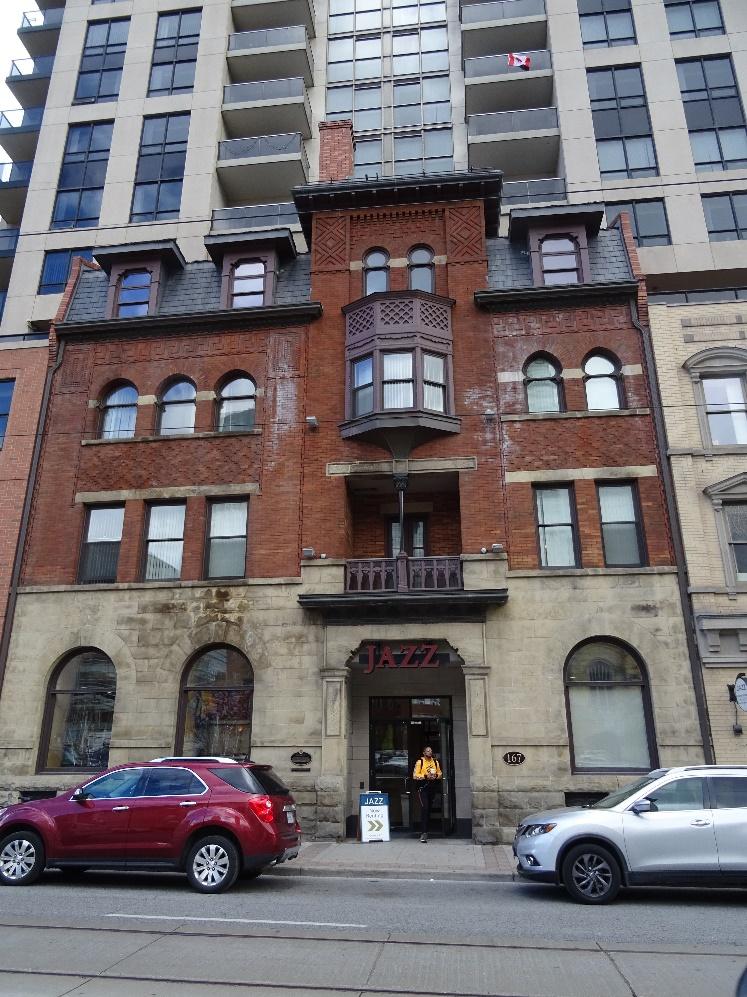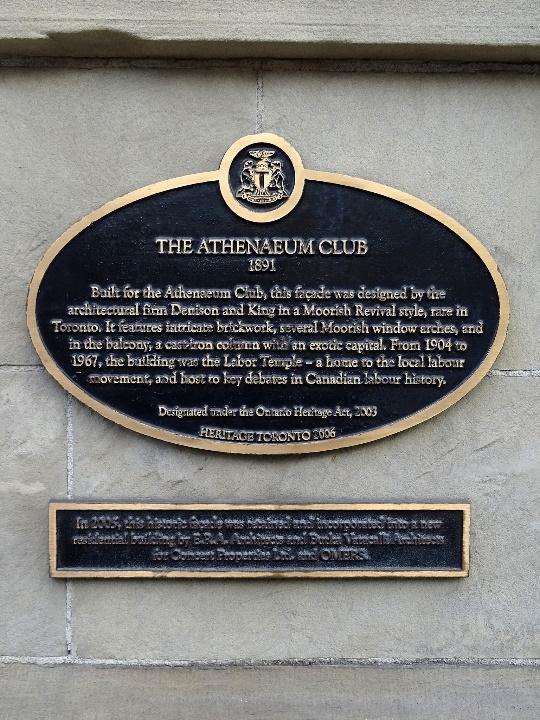Visual Representation


Site Description
The Athenaeum Club building is located at 167 Church Street and has a number of characteristic features that allow it to stand out from other houses. First of all, the visitor will see dark gray masonry. Round and square windows with various decorative metal grilles can be seen on the ground floor of the building. The peculiarity of the style is that the second and third floors of the building are made of brick, which significantly distinguishes the building, making it look more like a European style. In addition, it is necessary to highlight various arches, and on the fourth floor, there are dormer windows that are built into the roof. The entrance of the building is decorated with decorative stone. Above it is a small balcony, which is made in the Renaissance-era architecture style (Ontario Heritage Trust, n.d.). In general, it may be noticeable to the viewer that the building has a specific asymmetrical shape, giving it a special touch. In addition, the Heritage Toronto Plaque is located on the building itself, which refers to the fact that the club was located there.
The Events and Main Actors
The building at 167 Church Street, which was created in 1891 by architects Denison and King, is recommended for listing for cultural-historical grounds (Ontario Heritage Trust, n.d.). Numerous of Denison’s extant creations are included on the City of Toronto’s Inventory of Heritage Properties. He was a well-known architect who was born in Toronto (Ontario Heritage Trust, n.d.). The unique historical significance of this place is determined by the fact that quite serious and important events for the city and the country took place there. The main activity of the Athenaeum club is connected with the growing popularity of associations among the working class to realize and expand their rights and freedoms.
The building became a point of attraction for workers and politicians who sought to discuss pressing issues that allowed them to change the course of history. One of the critical events that occurred during that period of time can be considered the appointment and appearance of an official holiday – Labor Day (Ontario Heritage Trust, n.d.). Such an event may not initially seem very significant since it did not directly affect the situation of people. However, it is worth considering the context of the time, after which it becomes evident that such a step changed the idea the essence of the labor movement quite a lot, making it more influential. The very importance of the building is also determined by the fact that it was acquired by the local authorities, which subsequently transformed the sports club into a Labor Temple. Thus, there is a tendency that this place has had its political independence for 60 years (Micallef, 2015). Thus, this determines the significance of the club as one of the most important historical sites in Toronto dedicated to the development of the labor movement.
Of the positive changes, it can be highlighted that the problems discussed in this building were sufficiently crucial for the country’s entire population. This determined that the participants sought to provide the population with opportunities to increase wages and improve the overall quality of work and safety (Micallef, 2015). However, one of the defining achievements was the desire to give women more voting rights. Thus, taking into account the activities of a small and, at first glance, unremarkable building, it is possible to assess its significance for determining the course of development and formation of the whole country.
The Historical Significance
Initially, this place was intended for an athletic club. However, over time, the situation changed, and in the period from 1904-1968, the Toronto Trades and Labor Council owned the building, which served as the basis for further historical changes and events (Elwell, 2020). Most of the club was owned by various trade unions, which owned part of the shares. Consequently, this building became a place where the Labor movement actively conducted its activities (Elwell, 2020). This club is of particular historical value due to the actions that its members sought to conduct. During the discussions, issues related to state-owned properties of various necessary urban facilities existed. In addition, issues related to the population’s needs were also resolved. Moreover, the club played an essential role in resolving the issue of conscription during the World Wars.
People Involved and The Outcome
The historical significance of the place is determined by the fact that many workers and political figures were involved in its activities. Over time, this place was intensively used by the Toronto authorities in order to determine the needs and needs of the working class (Micallef, 2015). From the results of this cooperation, one can imagine how much the idea of the importance of the working population has changed. Of the apparent changes that occurred gradually, it is possible to single out the creation of a course to improve wages and workers’ safety. However, it should be understood that the Athenaeum Club has become a place of life change for workers and the entire population.
This is reflected in the fact that positive cooperation between the Government and the population played a significant role in general education development. It is crucial that this club played its role in solving the issue of the Consciousness Crisis of 1917, which was manifested in the fact that part of the French and English populations of the country had different views on participation in the war. The task of the club was to identify the actual needs of the people in order to indicate Toronto’s position on this issue.
Controversy of Significance
The assumption that the object of the site is controversial can be considered incorrect since the above facts testify to the importance of the club. It is necessary to pay attention to the fact that the population did not have enough opportunities to exercise their rights and freedoms at that time. The appearance of such a place does not necessarily mean rapid changes. However, its very existence made it possible to take the first steps toward realizing the idea of the labor movement. At the beginning of the 20th century, strong trends were redefining and reshaping public attitudes. The population became more educated, which was reflected in its desire to expand its rights. The Athenaeum Club has become a place where the population can directly connect with the elite’s representatives (Elwell, 2020). The possibility of such interaction is truly valuable, as it allowed the people of Toronto to solve specific, not fictional, problems.
Significance Today
It should be noted that Canada is a relatively highly developed country. All this is reflected in its population’s quality of life and work. That is why it should be pointed out that the Athenaeum Club played a fairly significant role in the development of the labor movement in Canada (Elwell, 2020). All this, in turn, is connected with the fact that this landmark serves as a rather important historical monument that preserves the values and ideas inherent in the creators and members of the club. It should also be noted that there is not enough information in open sources about this place. Consequently, it is difficult for people, especially tourists, to get acquainted with this side of the history of the country’s development. However, many buildings and monuments contain valuable information about how the labor movement formed in the country. In turn, the Athenaeum club has its own significance today, as it keeps crucial memories of the history of life and the struggle for the rights of the labor movement.
Feelings and Connections
During these years, the prerequisites for the creation of civil society and public security in the modern sense were formed in Canada, and in foreign policy, the prerequisites for broad international integration and globalization were formed. It should be noted that getting a powerful impetus for developing all aspects of life in these years became the basis for Canada’s further success (Heron & Smith, 2020). The conductor of this profound reform of Canadian society was the liberal government, which at that time was headed by William Lyon Mackenzie King. The reasons for such a wide political diversity in the 20s should be considered the change in Canadian society and the maturation of the need for a new reformation of public life in it (Heron & Smith, 2020). Consequently, being near this building, feelings appear that reflect the hope that people who participated in the club’s activities experienced. Thus, the importance of events and decisions made in this place becomes clear. This is manifested in the fact that by being close to a place, a person can easily realize how a small building can determine the course of the whole history.
Significance of the Place and Events
For me, this place and the events that took place are significant because they influenced the course of development of the city’s history and the country as a whole. The economic contrasts of expanding imperialism created a significant stratification of society unusual for Canada and caused, on the one hand, an increase in social tension and, on the other, an intensification of public actions to create new civil institutions (Heron & Smith, 2020). In the territories with the most significant social, political, and spiritual tension, workers, farmers, women, and other organizations and movements began to appear on a political and professional basis.
Moreover, their most significant activity was at the provincial level since, firstly, it was connected with solving specific issues of private and public life, and secondly, it took place in favorable conditions for the expansion of provincial rights at the expense of federal powers. It is very important that Mackenzie King and his government conducted the interaction of public structures and state institutions to solve civil and domestic political problems in Canada through dialogue and achieving civil-political agreement (Heron & Smith, 2020). All of this allowed creation of conditions for the sustainable formation and development of the Canadian liberal tradition.
References
Elwell, A. (2020). ICYMI: Toronto labor history walking tours. Labour Council of Toronto & York Region.
Heron, C., & Smith, C. (2020). The Canadian labor movement. James Lorimer & Company.
Micallef, S. (2015). Building blocks of city’s labor history.Toronto Star.
Ontario Heritage Trust. (n.d.). In the matter of the Ontario Heritage act R.S.O. 1990, chapter 0.18 and 167 Church Street.